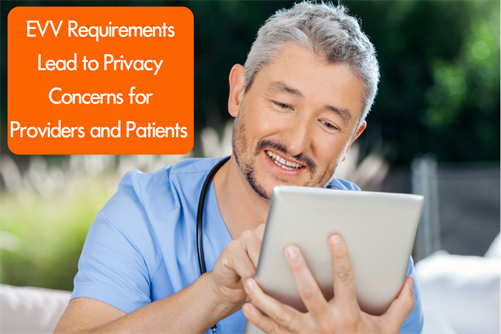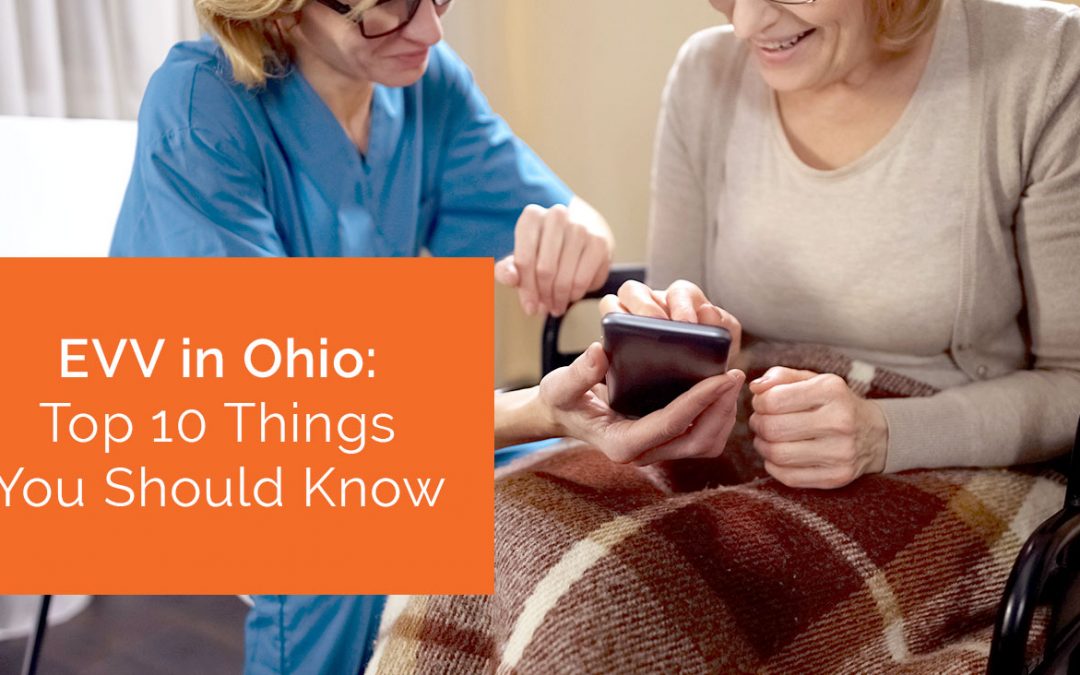As part of the 21st Century CURES Act, as of January 1, 2019, personal care aides must provide electronic visit verification (EVV) when making visits to Medicaid patients to provide services. The requirement extends to all home health services in 2023, but after a rocky rollout in Ohio earlier this year, there are some industry and patient advocates questioning the methods of EVV and the effect on patient and provider privacy.
Is “Big Brother” Watching?
The concept behind EVV is simple: By electronically verifying the date, time, and duration of services provided, the likelihood of fraud or abuse is decreased. In nearly every state, the costs to Medicaid of visits that aren’t actually made – or hours that are estimated or recorded incorrectly – are adding up. EVV is designed to increase the accuracy, not only ensuring that providers are only paid for the services rendered, but also that patients receive all of the services that they are entitled to.
When the Ohio EVV program rolled out last year, home health agencies and personal care providers had a choice to use a platform and devices provided by the state at no charge, or to pay for an approved EVV platform like Complia Health-Continulink. If the agency opted for the state-provided platform, patients receiving Medicaid services are given a device similar to a smartphone that stays with them at all times, and providers check in when they arrive for their visits on those devices, and check out when they leave. If the agency opted to invest in their own platform, the providers checked in using any device (such as a company-issued tablet or laptop), which then forwarded the data to the state processor to be used in processing claims.
Although most providers, patients and disability advocates do not have a problem with more accurate tracking of time and services, they do have a problem with the state-issued devices used for EVV. These devices are equipped with GPS, cameras and microphones, and advocates say that this potentially puts individual privacy into jeopardy. Representatives from Ohio Medicaid noted that the devices cameras are not operational, and therefore nothing is being recorded, but even so, patients have serious concerns about the devices’ GPS function.
Because patients need to have the devices with them if care begins or ends outside the home, the GPS function gives the state government details about how they spend their time and where they go. For instance, if an aide accompanies a patient to the grocery store and the pharmacy after meeting them at work, the device is recording that information, telling the government exactly where the patient went and for how long. As disability advocates note, this is a violation of privacy – and many equate it with “Big Brother” watching patients and providers.
This assumes, of course, that the devices work. Many home health providers in Ohio have reported issues with the state-issued devices, leading the state leadership to put the full rollout to all home health providers on hold until the bugs can be worked out.
Finding Alternatives
The majority of patients and providers don’t have an issue with EVV in the conceptual sense. In fact, when the system has worked correctly, claim denial rates have decreased substantially, dropping to 3 percent from 9 percent. However, glitches in the system have also prevented many claims from being properly processed; one agency noted that only about 10 percent of their visits were paid by Medicaid, with the others held up by EVV issues.
Even assuming that those glitches can be worked out, though, there is still the question of privacy. Patients who have publicly spoken out against the current methods say that they would be more comfortable with an app-based system, in which the provider logs into an app on their own device to verify the visit – like Complia Health. With this application, the provider simply needs to use a GPS-enabled device to check in and check-out. The device does not continuously record the GPS location, and the EVV is integrated into the patient files so the agency has an accurate and thorough record of all visits.
Industry experts note that the EVV question could have a far-reaching effect on home health care as a whole, because the new requirements and concerns about privacy have the potential to drive providers away. There is already evidence that some home health aides have left their jobs due to privacy concerns, and if the trend continues, an already understaffed field could really feel the pinch. Finding a better alternative to EVV that is easy-to-use and protects individual and provider privacy is a major priority.
To learn more about how Complia Health – Continulink can help your agency meet the EVV requirements while also streamlining operations and protecting privacy, click here.
As part of the 21st Century CURES Act, as of January 1, 2019, personal care aides must provide electronic visit verification (EVV) when making visits to Medicaid patients to provide services. The requirement extends to all home health services in 2023, but after a rocky rollout in Ohio earlier this year, there are some industry and patient advocates questioning the methods of EVV and the effect on patient and provider privacy.
Is “Big Brother” Watching?
The concept behind EVV is simple: By electronically verifying the date, time, and duration of services provided, the likelihood of fraud or abuse is decreased. In nearly every state, the costs to Medicaid of visits that aren’t actually made – or hours that are estimated or recorded incorrectly – are adding up. EVV is designed to increase the accuracy, not only ensuring that providers are only paid for the services rendered, but also that patients receive all of the services that they are entitled to.
When the Ohio EVV program rolled out last year, home health agencies and personal care providers had a choice to use a platform and devices provided by the state at no charge, or to pay for an approved EVV platform like Complia Health-Continulink. If the agency opted for the state-provided platform, patients receiving Medicaid services are given a device similar to a smartphone that stays with them at all times, and providers check in when they arrive for their visits on those devices, and check out when they leave. If the agency opted to invest in their own platform, the providers checked in using any device (such as a company-issued tablet or laptop), which then forwarded the data to the state processor to be used in processing claims.
Although most providers, patients and disability advocates do not have a problem with more accurate tracking of time and services, they do have a problem with the state-issued devices used for EVV. These devices are equipped with GPS, cameras and microphones, and advocates say that this potentially puts individual privacy into jeopardy. Representatives from Ohio Medicaid noted that the devices cameras are not operational, and therefore nothing is being recorded, but even so, patients have serious concerns about the devices’ GPS function.
Because patients need to have the devices with them if care begins or ends outside the home, the GPS function gives the state government details about how they spend their time and where they go. For instance, if an aide accompanies a patient to the grocery store and the pharmacy after meeting them at work, the device is recording that information, telling the government exactly where the patient went and for how long. As disability advocates note, this is a violation of privacy – and many equate it with “Big Brother” watching patients and providers.
This assumes, of course, that the devices work. Many home health providers in Ohio have reported issues with the state-issued devices, leading the state leadership to put the full rollout to all home health providers on hold until the bugs can be worked out.
Finding Alternatives
The majority of patients and providers don’t have an issue with EVV in the conceptual sense. In fact, when the system has worked correctly, claim denial rates have decreased substantially, dropping to 3 percent from 9 percent. However, glitches in the system have also prevented many claims from being properly processed; one agency noted that only about 10 percent of their visits were paid by Medicaid, with the others held up by EVV issues.
Even assuming that those glitches can be worked out, though, there is still the question of privacy. Patients who have publicly spoken out against the current methods say that they would be more comfortable with an app-based system, in which the provider logs into an app on their own device to verify the visit – like Complia Health. With this application, the provider simply needs to use a GPS-enabled device to check in and check-out. The device does not continuously record the GPS location, and the EVV is integrated into the patient files so the agency has an accurate and thorough record of all visits.
Industry experts note that the EVV question could have a far-reaching effect on home health care as a whole, because the new requirements and concerns about privacy have the potential to drive providers away. There is already evidence that some home health aides have left their jobs due to privacy concerns, and if the trend continues, an already understaffed field could really feel the pinch. Finding a better alternative to EVV that is easy-to-use and protects individual and provider privacy is a major priority.
To learn more about how Complia Health – Continulink can help your agency meet the EVV requirements while also streamlining operations and protecting privacy, click here.




